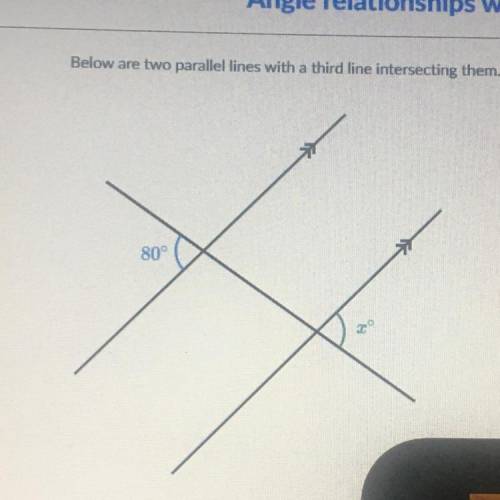Below are two parallel lines with a third line intersecting them
X=|_|°
...

Mathematics, 11.01.2021 14:00 villanuevajose95
Below are two parallel lines with a third line intersecting them
X=|_|°


Answers: 2


Another question on Mathematics

Mathematics, 21.06.2019 17:20
Asap describe the transformations required to obtain the graph of the function f(x) from the graph of the function g(x). f(x)=-5.8sin x. g(x)=sin x. a: vertical stretch by a factor of 5.8, reflection across y-axis. b: vertical stretch by a factor of 5.8,reflection across x-axis. c: horizontal stretch by a factor of 5.8, reflection across x-axis. d: horizontal stretch by a factor of 5.8 reflection across y-axis.
Answers: 1

Mathematics, 21.06.2019 18:30
Write a polynomial function f of least degree that has rational coefficients, a leading coefficient of 1, and the given zeros. 3, 4+2i, 1+(sqrt)7 the answer is supposed to be: f(x)=x(^5)-13x(^4)+60x(^3)-82x(^2)-144x+360 what am i doing wrong?
Answers: 1

Mathematics, 21.06.2019 20:40
Which function has an inverse function? a.f(x)= |x+3|/5 b. f(x)= x^5-3 c. f(x)= x^4/7+27 d. f(x)= 1/x²
Answers: 1

Mathematics, 21.06.2019 21:00
Asequence has its first term equal to 4, and each term of the sequence is obtained by adding 2 to the previous term. if f(n) represents the nth term of the sequence, which of the following recursive functions best defines this sequence? (1 point) f(1) = 2 and f(n) = f(n − 1) + 4; n > 1 f(1) = 4 and f(n) = f(n − 1) + 2n; n > 1 f(1) = 2 and f(n) = f(n − 1) + 4n; n > 1 f(1) = 4 and f(n) = f(n − 1) + 2; n > 1 i will award !
Answers: 1
You know the right answer?
Questions

Mathematics, 03.03.2020 04:31


History, 03.03.2020 04:31



Mathematics, 03.03.2020 04:31




Computers and Technology, 03.03.2020 04:31






Social Studies, 03.03.2020 04:31

Biology, 03.03.2020 04:31

Mathematics, 03.03.2020 04:31




